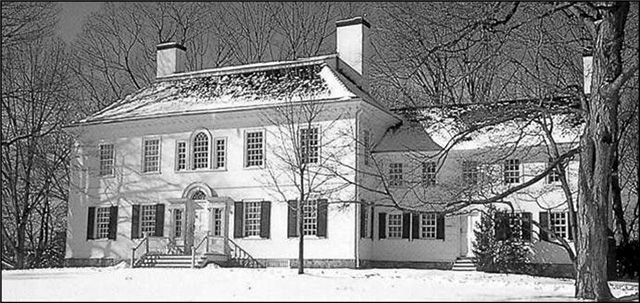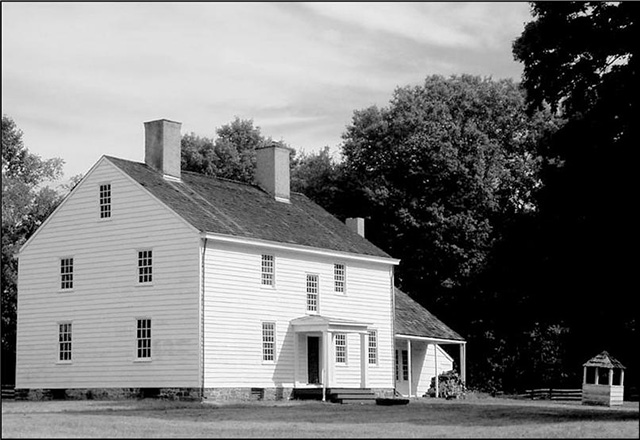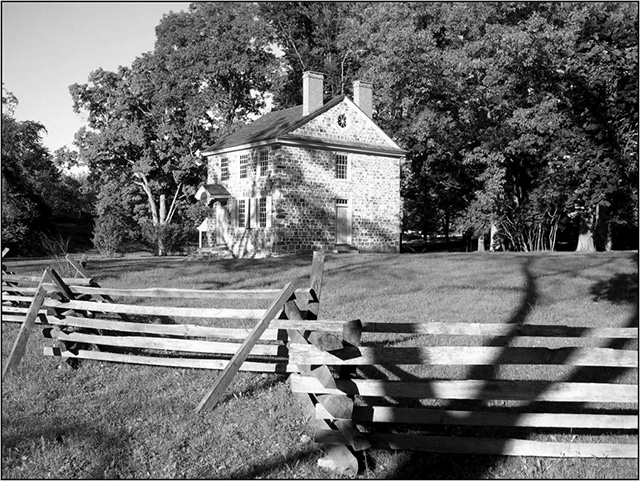|
Home : Quarterly Archives : Volume 43 |
Tredyffrin Easttown Historical Society |
|
Source: Summer 2006 Volume 43 Number 3, Pages 84–87 General Washington's Housekeeper Hint for using the footnote reference links: Using the “Back” feature of your browser will return to the previous [Note] link location after you read the footnote. The Delete (Mac OS) or Back Space (Windows) keys often perform this function. “George Washington slept here” is a phrase often heard in the northeastern United States. Washington may have done just that. Few realize that the commander in chief of the Continental Army slept in over 90 different homes and buildings during the long Revolutionary War. Washington stayed in 24 separate homes or public buildings in 1777 alone. [Note 1] To help make these transitions go smoothly, the general traveled with a “military family” that included his aides-de-camp and personal servants as well as two cooks, a laundress, and a housekeeper. Mrs. Elizabeth Thompson, a personable Irish woman, took on the position of Washington's housekeeper for most of the American Revolution. The demanding job of housekeeper for General Washington required stamina, vim and vigor - traits that are usually associated with the young. Mrs. Thompson clearly demonstrated stamina, vim and vigor, but she was not a young woman. She was 72 years old when she accepted the position of Washington's housekeeper. This intrepid woman moved up and down the northeastern coast for 5 years with the army, making sure that each of Washington's headquarters, in such places as Arnold's Tavern and the Ford Mansion in Morristown, New Jersey; Wallace House in Middlebrook, New Jersey; William Ellison's home in New Windsor, New York; and the Isaac Potts house in Valley Forge, Pennsylvania, were comfortable for the commander. She reluctantly retired in 1781, at the age of 77. [Note 2]
Above: Ford Mansion. Headquarters of Second Morristown (NJ) Encampment. Winter
1779-1780.
Below, Wallace House. Headquarters of Middlebrook (NJ) Encampment. Winter 1778-1779.
Elizabeth Thompson was not the first housekeeper Washington had employed. Mrs. Mary Smith had initially worked for the general. But after an anonymous letter arrived at headquarters hinting that Mrs. Smith doubled as a British spy, the housekeeper was abruptly dismissed from Washington's military family—and soon sailed to England. Mrs. Smith had served as the commander's housekeeper for just over two months—from early April to late June, 1776. [Note 3] Now Washington was, he wrote, “entirely destitute, & put to much inconvenience” because he had no housekeeper. Someone had to be responsible for ensuring that every change of the household ran smoothly. When Washington learned of Mrs. Elizabeth Thompson—she had been recommended to him as a “fit person”—he immediately sent for her to be interviewed for the housekeeper's position. [Note 4] Washington's aides quickly located her in the New York area, then sent word to the commander that Mrs. Thompson had received his invitation and had immediately agreed to join Washington's military family. The general, in fact, was to “Expect her the first Opportunity.” [Note 5] Mrs. Elizabeth Thompson began work on July 9, 1776 as housekeeper at army headquarters, then the New York City home of Abraham Mortier. On April 23, 1777, less than a year later, she received compensation for her services and was dismissed, probably because the spring campaign was about to open. [Note 6] Mrs. Thompson's departure may have been well-considered by General Washington, but it surprised and annoyed his wife. Martha Washington informed the commander that she had wanted to employ Mrs. Thompson herself if he did not need the services of the housekeeper. In a letter to Captain Caleb Gibbs on May 1, 1777, General Washington put the domestic tension this way: “Mrs. Washington wishes I had mention'd my intentions of parting with the old Woman before her, she is much in want of a Housekeeper.” [Note 7] One can almost hear Martha Washington gently chastising her husband for, as she saw it, impulsively dismissing the housekeeper without consulting her, and then prodding him to use his connections to assist her in finding good household help for Mount Vernon. So, prompted by his wife, Washington wrote around to inquire into the whereabouts of his former housekeeper. Mrs. Thompson was back to work within days, not with Mrs. Washington at Mount Vernon, but at army headquarters, which was then located at Arnold's Tavern in Morristown, New Jersey. Mrs. Elizabeth Thompson was 74 when she came to the 1777-1778 Valley Forge winter encampment. She lived in the headquarters building, the small, five room Isaac Potts house, with General and Mrs. Washington and the other 25 or so members of the general's military family. Her days were very busy and filled with a variety of tasks. She supervised Isaac the cook and his assistants and made sure dinner was served promptly at three each afternoon, just as the commander in chief wanted it. She took charge of the laundresses and the other household servants. Mrs. Thompson made certain the housework was done to her satisfaction, inspected the linens and the cutlery, and ordered the food. The housekeeper arranged the settings of each room so each guest had a comfortable place to stay, and made certain that the beds were made up right. [Note 8] As part of her responsibilities, Mrs. Thompson supervised the packing and unpacking of headquarters each time General Washington shifted locations. When Martha Washington traveled during the Revolutionary War to the winter encampments - and General Washington's lady came to all eight encampments - Mrs. Thompson took orders from her.
Isaac Potts House. Headquarters of Valley Forge (PA) Encampment. Winter 1777-1778. Because she could neither read nor write, Mrs. Thompson did not personally keep account of the household expenses as Mrs. Mary Smith had done. Caleb Gibbs kept account of Washington's household expenses during most of the Revolution, and Gibbs' receipt books are full of fascinating minutia about life at the general's headquarters. While at Valley Forge, the receipt book says, Mrs. Thompson was reimbursed for buying some “small articles” for the house on June 5, 1778. She occasionally purchased items for the household and Washington's military family while at other encampments, too. Expenses for her travel expenses show up on the receipt books. She received a pair of shoes on February 14, 1780. Mrs. Thompson's salary was in dollars, guineas, pounds, and shillings, making it impossible to calculate in today's dollars. And, like many of the soldiers and officers themselves, the housekeeper did not stay the entire six months at Valley Forge. According to the account books, a wagon and driver were sent from camp on March 10, 1778, to “fetch” her from Newtown, Pennsylvania, were she was possibly visiting relatives. [Note 9] Although servants in the eighteenth century were customarily referred to by their first names, Washington's housekeeper is referred to only as “Mrs. Thompson” in Revolutionary War accounts. People liked her. Dr. James Thacher, a surgeon for the Continental Army, called Mrs. Thompson “a very worthy Irish woman.” [Note 10] Martha Washington, who has the reputation of being a fastidious housekeeper herself, liked her husband's housekeeper so much that she wanted to employ her at Mount Vernon. General Washington, too, liked Mrs. Thompson and her work. Nevertheless, in December 1781, at the age of 77, “Age made it necessary” for Mrs. Thompson's job as Washington's housekeeper to end. [Note 11] Military headquarters at that time was the Benjamin Chew townhouse in Philadelphia. Surprisingly, the commander in chief of the Continental Army and his housekeeper kept in touch after she retired from her duties. Mrs. Thompson received some money from Washington on September 16, 1783, “in part for services done in his Family.” [Note 12] Just two days later, General Washington found himself needing a “good Cook, German I should prefer.” He wrote his aides that Mrs. Thompson, now described as “formerly my Housekeeper,” could assist in selecting the candidates. The commander in chief, incidentally, required as a cook a “Person that has understanding in the business, who can order, as well as get a dinner; who can make dishes, and proportion them properly, to any Company which shall be named to him to the amount of 30.” [Note 13] In October 1783, John Trumbull penned a letter to His Excellency George Washington on Mrs. Thompson's behalf. Although the letter does not discuss whether or not Mrs. Thompson helped locate a new cook, it does give up some hints as to why this woman was held in such high regard. She was an enthusiastic and devoted worker, as she had come to work for the General, her letter said, “with a zealous Heart to do the best in my Power.” She was a modest woman, as she writes that her service “was never equal to what your Benevolence has thus rated them.” She had a wonderful relationship with the General, as she wrote with confidence that “should I ever want, which I hope will not be the Case, I will look up to Your Excellency for Assistance, where I am sure I will not be disappointed.” And she had a sense of fun about her, as she signed herself, “Your Excellency's Old Devoted Servant, Elizabeth Thompson.” [Note 14] Two months after this letter was written, Mrs. Thompson received $240.00 “in full of Account for Services” with General Washington's family. [Note 15] Money continued to be tight. On February 17, 1785, a letter was sent to Congress under Mrs. Thompson's signature asking for a small sum for the former housekeeper, now 81, to enable her to “close her eyes in peace.” According to the letter, Washington had invited his frail, esteemed former housekeeper, who was staying in New York at the time, to live out her final days at Mount Vernon. Because Mrs. Thompson had a “heap of infirmities,” however, “such a journey appears impossible.” [Note 16] Congress, demonstrating an uncharacteristic burst of speed, responded to Mrs. Thompson's request for money by awarding her the very next day an annual pension of $100.00 for the remainder of her life. [Note 17] It is unknown when Mrs. Elizabeth Thompson died, or where she died. Nor is it known where this respected housekeeper of the American Revolution is buried. So when you next visit Washington's headquarters at Valley Forge National Historical Park, think of Mrs. Elizabeth Thompson. It is well known that General and Mrs. Washington slept in the Isaac Potts house during the winter of 1777-1778. But how many are aware that Mrs. Thompson, Washington's housekeeper during the American Revolution, slept there, too? Or that she was 74 years old at the time. ACKNOWLEDGEMENTS The author thanks the following for their contributions to this article: Ajena Rogers, Interpretive Ranger at Valley Forge National Historical Park; Dona McDermott, Archivist at Valley Forge National Historical Park; and Joseph Lee Boyle, Retired Historian at Valley Forge National Historical Park; and Morristown National Historical Park. DOCUMENTATION
SOURCES Menz, Katherine B. Historic Furnishings Report of Washington's Headquarters, Valley Forge National Historical Park. Harpers Ferry Center: National Park Service, 1988. Thacher, James, M.D. Military Journal of the American Revolution 1775-1783. Gansevoort, N.Y.: Corner House Historical Publications, 1998. Reprint of original edition published in 1862 by Hurlburt, Williams and Co. Hartford, CT. The George Washington Papers at the Library of Congress, 1741-1799. Series 4. General Correspondence. Online. http://memory.loc.gov/ammem/gwhtml/gwser4.html The George Washington Papers at the Library of Congress, 1741-1799. Series 5. Financial Papers. Online. http://memory.loc.gov/ammem/gwhtml/gwseries5.html “The George Washington Papers at the Library of Congress, 1741-1799,” from The Writings of George Washington from the Original Manuscript Sources, 1745-1799. Edited by John C. Fitzpatrick. Online. Washington, George. The Papers of George Washington, Revolutionary War Series. Edited by Philander D. Chase. Vol. 5. Charlottesville, VA: University Press of Virginia. 1993. Washington, George. The Papers of George Washington, Revolutionary War Series. Edited by Philander D. Chase. Vol. 9. Charlottesville, VA: University Press of Virginia. 1998. Nancy K. Loane, a former seasonal ranger at Valley Forge National Historical Park, researches, lectures, and writes on the women of the 1777-1778 Valley Forge encampment. |


